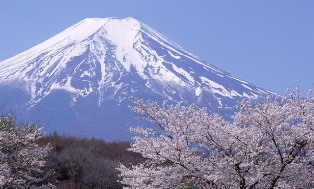Before anything else, I want to express my heartfelt thanks to the Embassy of Japan in Greece, the Japanese Ministry of Foreign Affairs, and everyone involved in this project. I feel deeply grateful for being given the opportunity to visit Japan under such privileged circumstances. In particular I wish to thank our escorts, Michiyo-san, Santaro-san and Yoko-san, for tirelessly accompanying and taking care of us throughout our trip.
First Impressions
The excitement started at Frankfurt's airport, when one by one the members of our group began to arrive. We happily started chatting, asking each other which country we came from and how we found out about the Study Tour. Then came the long flight to Narita Airport, at which we were welcomed by our escorts, Michiyo-san and Yoko-san.
Tokyo
On the bus that took us from the airport to the hotel, I kept looking outside the window, trying to take in as much of the scenery as possible. How excited I was when I saw a small rice field amidst the low hills near the highway! As we entered Tokyo, the scenery became more urban, with many skyscrapers and enormous apartment blocks. Finally, we arrived at our hotel, where we took some time to relax before going to the welcoming reception organized by the Ministry of Foreign Affairs. There we had the opportunity to meet with representatives from the EU embassies as well as representatives from the various venues we were scheduled to visit during our trip. Later that evening, we went on a little exploration of the surrounding area. Our hotel was situated near Zojo-ji Temple (which we resolved to visit early next morning) and the Tokyo Tower – a pretty imposing sight up close! With that, the last reserves of energy I had were spent, and after bidding goodnight to my newly - found comrades, I went to my room for a good night's sleep.
Waking up reinvigorated the next morning, we set off after a good breakfast (complete with steamed rice, miso soup and pickled plums) for our visit to the nearby temple. Although it was early in the morning, we were amazed to see office workers, in their work suits and carrying their briefcases, quietly stopping at the temple for a quick offering of prayers. The tranquility of the place, combined with the smell of the burning incense, made me feel for a moment as if I was in a monastery deep in the mountains, rather than at the heart of a city with a population exceeding that of Greece!
After that small excursion, we left for our first lecture at the MOFA headquarters, followed by a visit to the Sogetsu – Kaikan for an
ikebana (flower arrangement) demonstration. I was truly impressed with the results one can get by combining the right flowers with the right containers. When the demonstration was over, we were presented by an array of flowers, branches, leaves and containers to choose from and left to create our own arrangement. We turned out some quite beautiful creations. After an experience like that, simply putting roses into a vase will not do for me anymore!
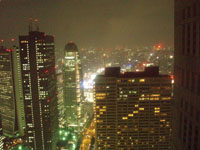 Our day was concluded with a visit back to MOFA and the second and final lecture of the day on kaizen – or the concept of “gradual improvement” – as it is found in simple products of everyday use. A stapler with a 360 o rotating arm really had me hooked; I never missed an opportunity to look for a similar one for the rest of the trip! Then it was back to the hotel and dismissed for the day. But trying to see as much of Tokyo as possible, a small group of us took the Metro and went to the Government Building Observatory in Shinjuku, where we could see a panoramic view of the city by night – miles and miles of twinkling electrical lights all around. Then we explored the area a little, ending up in a small eatery in one of the many tiny side-streets, where we had our first Japanese dinner, complete with Japanese beer.
|
 The next day a small company of us visited the Tsukiji Fishmarket and watched the tuna auction at 6 am. Tsukiji Fishmarket is a huge area, and once you enter it you are overwhelmed by the number of stalls displaying an unimaginable diversity of fish, shellfish and other fish products.
Next in the day's agenda was another visit to MOFA for a lecture on Japanese Economy, and then we set off to visit the Japanese Parliament, called the Diet.
It is a magnificent building, particularly the rooms used by the Emperor – one of the most exquisite samples of traditional wall-making I've seen sofar.
|
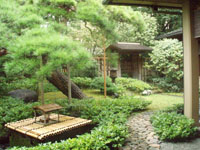 After this it was the tea ceremony's turn, for which we were honored with an invitation by the Master of the Urasenke School. The house were the ceremony was performed is relatively new – only 15 years old.
But it is build entirely in a traditional style, on the site of a former daimyō' s estate, around a lovely garden which includes a 400-year-old pine tree.
After the ceremony we went back to MOFA for the last lecture of the trip on Japanese modern politics, and then back to the hotel. There was a very solemn atmosphere about the day's activities, and although we enjoyed it we decided to explore the more fashionable side of the city that night, so we paid a visit to Akihabara district for a whiff of anime and manga.
|
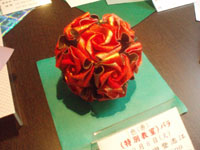 Next morning we started by visiting the Meiji Jingu shrine. We were given a tour of the shrine which included attending the daily service, a lecture on Shinto and the religion regime in Japan and our very own group ritual purification by two shrine maidens. After the purification we were given a sip of the offering of sake, which made me think of my own religion's Holy Communion, and how, despite their fundamental differences, both practices (Shinto and Christianity) express their beliefs in very similar “terms”.
Following the schedule we visited the Origami-Kaikan for a demonstration on the ancient art of paper folding, and then we went to a small factory that manufactures glass windbells, where we saw how the bells are made and were given our own bell to decorate and take home.
|
After that we were free for the day, so a few theatre lovers among us decided to go to a theatre performance at Kabuki-za. We watched what seemed to me as a “misunderstandings' comedy” (as we would say in Greek), about a fox trying to recover a drum made from its dead parents' skin. What I enjoyed the most, apart from the costumes, were the people in the audience shouting the names of the actors' schools – as an encouragement, we were later told. One of them was sitting right behind us, and the first time he shouted a name we were literally scared out of our seats!
The day after we visited Honda's Saitama factory, where we had the opportunity to observe the more industrious side of Japan. To me however, what was more impressive, even than the extremely efficient assembly line, was the way the company was organized, from realizing and implementing an automobile design to the initiatives for reducing carbon footprint, training workers and establishing good relations between the personnel of all levels. After the factory it was time for our visit to a local college. Tsuda College was founded in 1900, one of the first institutions for higher education for women in Japan. It remains an all-women college to this day, and the discussion with the students there gave us new viewpoints on life in Japan.
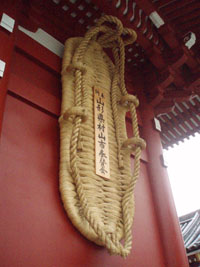 Finally, on our sixth day of stay we had a morning of free time to roam the streets of Tokyo. Most of us decided to do some shopping combined with sightseeing, so off we went to different directions.
Our small group visited Asakusa and the Senso-ji Temple with the huge lantern at the front gate – and the equally huge hemp slippers hanging at the inner gate.
We took our time browsing through the many shops between the gates, and we bought loads of okashi (sweets) to take back home.
|
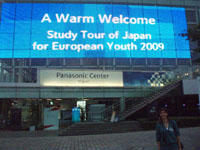 Later that evening we visited the Panasonic Centre in Odaiba, where we were shown demonstrations of the new technology developed by the company, and also had a tour in their exhibition centre. I fell in love with their household appliances that conserve so much water and energy!
After that technological intervention, we went to see a Taiko drum performance by a local group, the Nagisa Taiko. The mothers of the group had very kindly cooked a variety of delicious Japanese dishes for us, and after the performance, we ate, drank and sang karaoke to our hearts' content! That was our final night in Tokyo, and because we had to get up early the next morning to catch the flight to Hiroshima, some of us decided to call it a day and go to bed early. |
Hiroshima
We took off from Haneda Airport the next day in glorious sunshine, and the weather didn't change when we arrived at Hiroshima. I was struck at how green the countryside was. Everywhere I looked there were rice fields and trees, and the buildings were mostly constructed with the traditional slanted roof, so the overall feeling was entirely different from the one I got on the way to Tokyo the week before.
We arrived at the International Conference Centre at the Hiroshima Peace Memorial Museum, where after a quick lunch we met our host families. I stayed with a typical Japanese family at one of the suburbs of Hiroshima. We spent a quiet evening at home, where I was most generously allowed to try on a
furisode , the long-sleeved kimono worn by the unmarried women in Japan, and we cooked
ookonomiyaki for dinner. After the meal, I was instructed on the use of
kendama and
koma (traditional wooden toys) by the children of the family, had a traditional japanese bath and went on to sleep in a
futon on a proper
tatami floor.
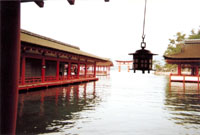 The next morning we visited the nearby Itsukushima Island, where the Miyajima Shrine is located. The Shrine is a UNESCO World Heritage site, and the most famous landmark is the great red “floating” Torii gate in the sea next to the temple complex. It is a beautiful place, and it was a pity we couldn't spend more time there.
But, we had to go back to meet with the rest of the group for our scheduled visit at Hiroshima's Peace Memorial Museum.
|
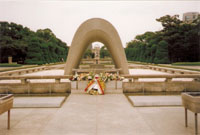 At the museum, we attended a lecture by an A-bomb survivor.
This first-hand account of the events of that fateful day, along with the viewing of some films and the subsequent visit to the museum and the surrounding park put the group on a more sombre mood. More than anything however, I think what most of us felt was closer to bewilderment.
Somehow it was impossible to grasp the desolation that existed just half a century ago on the very same ground we stood on.
|
Kyoto
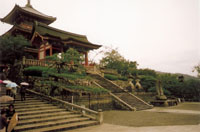 The next morning we took the bullet train to Kyoto. After a quick lunch of traditional Kyoto cuisine, we visited the most famous landmarks of the area, starting with Kiyomizu-dera temple and continuing with Kodai-ji temple, before heading off to spend the night at a traditional Japanese inn. Sightseeing continued the next day too, with Kinkaku-ji, Heian-Jingu, Nanzen-ji and finally, the Nijo-jo castle, the Togugawa Shoguns' official residence in Kyoto. The castle's wall paintings were truly astounding, and the wooden nightingale floors, the life-sized mannequins and the surrounding garden helped transport us to a different time in history.
|
Unfortunately our visit was cut short by the typhoon that was already passing over Japan the night before. To avoid getting stuck at Osaka we had to fly out that evening to return to Narita, from where we would catch the flight back to Frankfurt next morning. That didn't put us off at all though, and we spent our last evening together in one of the hotel's meeting rooms, chatting, eating snacks, drinking juice and beer from the vending machines, listening to music, and making origami creatures!
Departure
The next morning we took the bus to the airport under strong wind and rain – sure signs of the typhoon raging nearby. Thankfully it didn't pass too close to the airport, so our flight schedule wasn't jeopardized. After checking in our luggage, it was time to say good-bye to our escorts. It was a very sentimental farewell, since we had shared so much over the past days, and we didn't know whether we would see each other again. So, away we went, and after the plane arrived at Frankfurt, our group was finally disbanded. But we left with the promise to meet again one day, hopefully one not too far away.
This trip was, for me, a lifetime's dream come true. I finally had the chance to visit the place that I had read about in books and seen on documentaries, and it was so much better, so much more than I had ever imagined.
I returned home a wiser person, for having met the people I met and having experienced this diverse culture, and with a renewed determination to visit Japan again in the future – a bit more fluent in the language this time!
